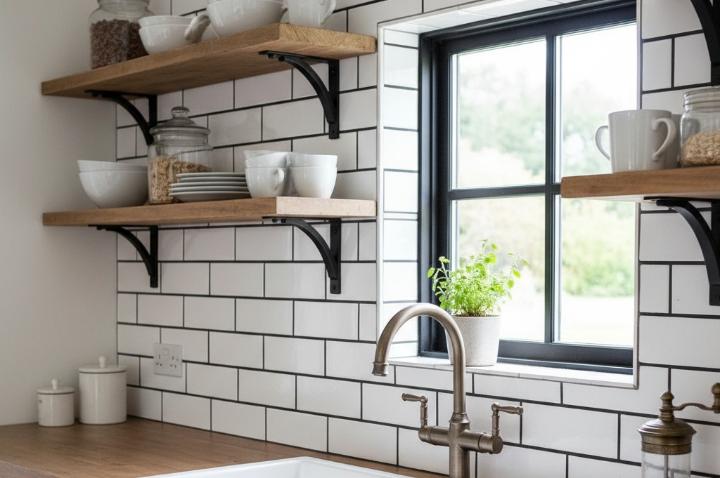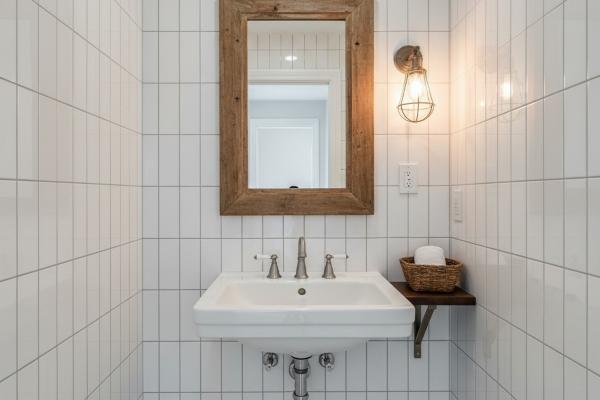Subway tile works beautifully in farmhouse interiors because its rectangular shape and modest proportions echo the practical, unpretentious materials that define authentic rural architecture. These tiles deliver the balance between simplicity and character that farmhouse design requires, offering a clean backdrop that enhances rather than competes with natural wood, vintage fixtures, and handcrafted details. Whether installed in classic running bond or arranged in creative subway tile layouts like herringbone subway tile backsplash or vertical subway tile patterns, this format brings structure without fuss. Northern Nevada's premier tile showroom offers comprehensive selections for farmhouse projects.
The farmhouse aesthetic celebrates materials that perform reliably while developing character over time, making subway tile an ideal choice for kitchens, bathrooms, mudrooms, and laundry areas. Modern subway tile patterns adapt to both restored historic homes and contemporary builds inspired by agricultural architecture. When planning your farmhouse project, browse tiles organized by style to discover how different finishes and colors can support your vision while maintaining authentic character.
Color Selection Strategies for Farmhouse Aesthetics
Classic white subway tile remains the cornerstone of farmhouse tile design because soft, clean neutrals reflect agricultural heritage where whitewashed walls created bright, sanitary work areas. White tiles in matte or glossy finishes deliver the crisp backdrop farmhouse spaces need. Glossy white creates luminous surfaces that bounce light throughout darker rooms, while matte white offers subtle texture that reduces glare. Montera 2.5x9 Glossy Porcelain Subway Tile demonstrates how slightly varied white tones add depth while maintaining simplicity.
Cream and warm white subway tiles provide gentler alternatives that pair beautifully with honey-toned woods and aged brass fixtures common in farmhouse kitchens. These warmer neutrals prevent stark, clinical feelings while offering welcoming warmth. Colored subway tile expands possibilities when used thoughtfully-soft sage greens, dusty blues, and muted terracotta's connect to natural landscapes without feeling trendy Shop tiles by color to explore how different shades interact with your existing materials.
Gray subway tiles bridge farmhouse and modern sensibilities, offering sophistication without losing rustic charm. Light to medium grays complement stainless appliances while maintaining farmhouse warmth when paired with wooden elements. Choose warmer grays with taupe undertones that harmonize with natural materials rather than cool, industrial-feeling blues.
Grout Choices That Define Character
Subway tile with dark grout creates bold grid patterns that many associate with classic farmhouse kitchens, providing definition while hiding stains better than lighter alternatives-a practical consideration for working spaces. This combination works especially well in larger areas where grid patterns help organize expansive walls. According to kitchen trend insights, contrasting grout continues gaining popularity as homeowners seek character-rich surfaces.
White or matching grout creates seamless surfaces emphasizing tiles rather than installation grids. This approach suits farmhouse spaces seeking quiet sophistication, allowing wood, stone, and metal elements to provide visual interest. Medium gray grout occupies useful middle ground, providing subtle definition without stark contrast or maintenance challenges of pure white.
Grout width matters significantly in farmhouse applications. Standard 1/8-inch joints produce traditional grid patterns referencing historical installations, while wider joints emphasize handmade quality farmhouse design celebrates. Professional installation guidance from the Ceramic Tile Foundation ensures proper joint sizing for your specific tile choice.
Layout Patterns That Add Farmhouse Authenticity
Traditional running bond-horizontal tiles with staggered joints-remains the safest choice for farmhouse projects, working universally across backsplashes and walls. Herringbone subway tile backsplash arrangements introduce sophisticated geometry while maintaining warmth. This layout works well with porcelain subway tiles offering consistent sizing.
Vertical subway tile installations create height-emphasizing surfaces ideal for bathrooms with standard ceilings. Bathroom remodeling examples showcase how vertical patterns create distinctive character. Basketweave patterns produce textile-like surfaces celebrating handmade details, while chevron creates pointed zigzag patterns delivering visual drama when executed in neutral colors.
Material Considerations for Farmhouse Longevity
Porcelain subway tiles provide enhanced durability, stain resistance, and moisture impermeability that matter in farmhouse kitchens and bathrooms seeing heavy daily use. The denser material withstands impacts better and maintains appearance longer than ceramic, making it superior for floor installations or areas prone to moisture exposure. Porcelain versus ceramic comparisons detail how material density affects long-term performance. Explore premium tile brands and material options to find the right fit for your farmhouse vision.
Textured porcelain tiles like Bristol 3x8 Glossy Ridge or Flat Porcelain Subway Tile add dimensional interest that enhances farmhouse spaces through shadow play and tactile variation. Three-dimensional surfaces create organic movement that feels handcrafted rather than industrial, aligning perfectly with farmhouse values around artisan quality.
Room-Specific Applications for Maximum Impact
Kitchen Backsplashes: Subway tile excels behind ranges and sinks where water resistance meets farmhouse aesthetics. Consider creative backsplash ideas that incorporate decorative inserts without compromising simplicity.
Bathroom Walls: Full-height installations create seamless surfaces pairing beautifully with wooden vanities and vintage fixtures. White or cream tiles with dark grout produce classic farmhouse bathroom aesthetics.
Laundry and Mudrooms: Install tiles behind sinks and washing machines to create practical surfaces that elevate utility rooms. Professional installation guidance ensures proper substrate preparation.
Balancing Cost and Quality
Factor | Budget Approach | Premium Approach | Best Value |
Material | Standard ceramic | High-end porcelain | Mid-grade porcelain |
Size | 3x6 inches | 2x8 or custom | 3x6 or 4x12 inches |
Finish | Simple glossy | Textured/handmade | Matte standard |
Pattern | Running bond | Herringbone/chevron | Running bond or vertical |
Coverage Area | Backsplash only | Full walls, multiple rooms | Strategic feature areas |
Budget-conscious projects should prioritize quality materials in highly visible areas like kitchen backsplashes while using less expensive options in utility spaces. Focus on proper installation over premium tile selection-even basic ceramic looks excellent when properly installed. Home renovation planning resources help allocate budgets effectively.
Mid-range porcelain subway tiles deliver best value for most farmhouse applications, offering durability justifying slightly higher costs without reaching designer price points. Invest in professional installation for complex patterns or large areas; even moderately priced tiles look expensive when expertly installed.
Installation Guide for Farmhouse Success
Step 1: Prepare Surfaces Thoroughly Ensure walls are clean, dry, and properly primed. Use appropriate backer board in wet areas and verify surfaces are level.
Step 2: Plan Layout Precisely Dry-fit tiles before mixing adhesive to identify where cuts fall and ensure symmetrical layouts around focal points.
Step 3: Execute Clean Installation Apply thin-set mortar evenly using appropriate trowel sizes. Use spacers to maintain uniform grout joints. Proper tiling technique videos demonstrate best practices.
Step 4: Allow Proper Curing Time Let tile adhesive cure fully according to manufacturer specifications before grouting-typically 24 to 48 hours.
Step 5: Grout and Seal Appropriately Mix grout to proper consistency and work into joints using rubber float at 45-degree angles. Apply quality sealers after full curing to protect against staining.
Design Details That Enhance Farmhouse Character
Combine standard subway tiles with decorative options like Terrazzo 3x3 Matte Finish Porcelain Mosaic Tile as accent rows without overwhelming simplicity. Browse complete tile type collections to discover complementary materials. Subway tile provides the neutral foundation for farmhouse elements like butcher block counters and vintage lighting. Linear 5x10 Glossy 3D Decorative Subway Tile introduces architectural depth through shadow play.
Where to Source Quality Materials
Working with knowledgeable suppliers ensures you receive materials suited to specific applications. Visit showrooms where you can see actual samples rather than relying on online images-physical samples reveal texture variations photographs cannot capture. Many suppliers offer sample programs for testing tiles in your actual space. Design consultation services help refine selections and ensure cohesive results.
Avoiding Common Farmhouse Tile Mistakes
Choosing Inappropriate Sizes: Standard 3x6-inch subway tiles work beautifully in most farmhouse applications. Avoid oversized formats that feel too contemporary. Reference installation planning guidelines when budgeting resources.
Using Trendy Colors: Stick with whites, creams, soft grays, and muted earth tones that remain appropriate decades from now. Kitchen flooring maintenance advice emphasizes timeless material selection.
Neglecting Grout Selection: Grout impacts final appearance as significantly as tile choice. Test grout samples against chosen tiles in actual project lighting before installation begins.
Comparing Farmhouse Subway Tile Options
Pros of Subway Tile in Farmhouse Design
Timeless aesthetic that has remained popular for over a century
Versatile application across kitchens, bathrooms, laundry rooms, and mudrooms
Easy maintenance with basic household cleaning products
Multiple pattern options from traditional running bond to sophisticated herringbone
Wide availability at various price points and finishes
Excellent moisture resistance for high-moisture applications
Cons of Subway Tile in Farmhouse Design
Common appearance requires thoughtful grout and pattern choices for distinctiveness
Grout maintenance demands regular cleaning and sealing
Installation labor costs increase for complex patterns
Potential coldness without careful balance through warm materials
Conclusion
Subway tile delivers exceptional value for farmhouse interiors through its balance of practical performance, timeless aesthetics, and design versatility. The rectangular format honors farmhouse principles of simplicity and authenticity while providing clean, functional surfaces. Whether you choose classic white tiles with dark grout in traditional running bond or explore subway tile kitchen ideas with herringbone arrangements, this format adapts beautifully to various farmhouse interpretations.
Success requires thoughtful attention to color selection, grout choices, pattern placement, and material quality. Focus on creating cohesive spaces where tiles support rather than dominate. Proper installation and regular maintenance ensure surfaces maintain their fresh appearance for decades. Browse our complete tile selection to discover colors, finishes, and sizes suited to your specific vision. Explore tiles organized by size to find dimensions perfect for your renovation. Contact our design specialists to discuss your farmhouse tile project and receive personalized recommendations.
Frequently Asked Questions
What color subway tile works best for farmhouse kitchens?
White and cream subway tiles remain the most farmhouse-appropriate choices because they reflect agricultural heritage while providing neutral backdrops for natural wood and vintage fixtures. Soft grays and muted earth tones also work well when paired with warm undertones that prevent cold, industrial appearances.
Should I use glossy or matte subway tile in farmhouse bathrooms?
Matte finishes typically feel more authentic to farmhouse aesthetics through subtle texture and reduced reflectivity, though glossy tiles work beautifully when balanced with rustic elements like wood vanities. Glossy tiles brighten darker bathrooms by reflecting available light, while matte options create softer atmospheres.
Can I install subway tile myself or should I hire professionals?
Simple running bond patterns on backsplashes are reasonable tasks for capable DIYers with proper tools. However, complex layouts like herringbone subway tile backsplash or full bathroom installations justify hiring experienced installers who ensure proper substrate preparation and precise pattern execution.
How do I maintain subway tile grout in farmhouse kitchens?
Clean grout regularly with pH-neutral cleaners and soft brushes to prevent soil buildup. Seal grout lines annually to maintain stain resistance and water protection, particularly important with light-colored grout in cooking areas. Address stains promptly with oxygen-based cleaners.
What subway tile size works best for small farmhouse bathrooms?
Standard 3x6-inch subway tiles work beautifully in compact bathrooms, providing visual interest without overwhelming limited space. Vertical subway tile installations help small bathrooms feel taller by drawing eyes upward, while horizontal running bond creates width perception.


